Intercultural Management: A Comparative Analysis of Curacao
VerifiedAdded on 2020/04/15
|16
|3870
|295
Report
AI Summary
This report provides an analysis of intercultural management, focusing on the cultural aspects of Curacao and comparing them with other countries. The report begins with an introduction to the importance of local culture in business relations and the need for effective intercultural environments in a globalized world. It then analyzes Curacao's cultural dimensions using the CAGE framework, examining cultural, administrative, geographical, and economic distances. The report further employs the Hofstede and Hall frameworks to compare Curacao's culture with those of other nations like India, Russia, and Saudi Arabia, evaluating dimensions such as power distance, individualism, masculinity, uncertainty avoidance, long-term orientation, indulgence, time, space, and communication context. The analysis highlights the impact of cultural differences on business practices and communication styles, concluding with recommendations to address potential cross-cultural dilemmas in the global business environment. The report emphasizes the importance of understanding cultural nuances to enhance creativity, remain competitive, and foster effective international collaborations.
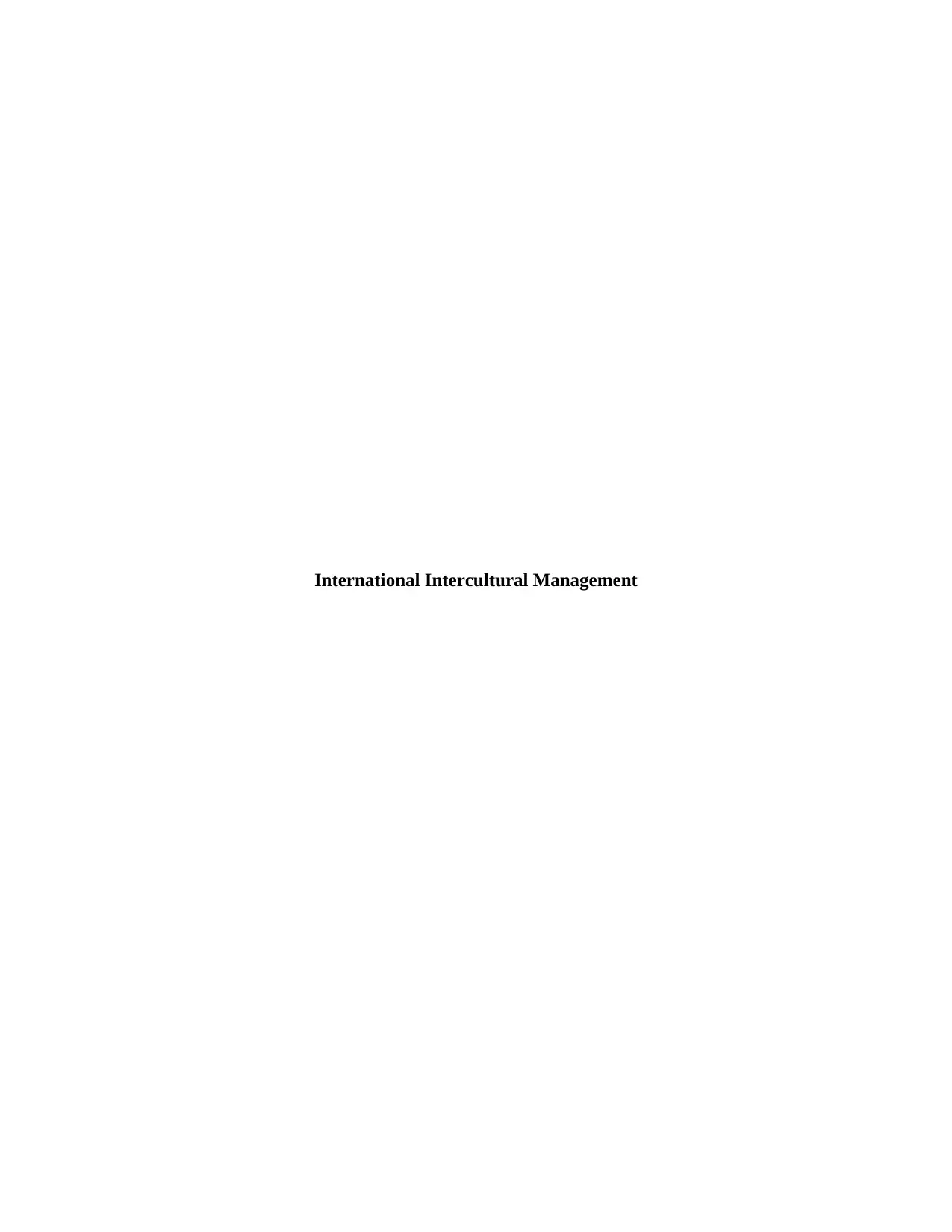
International Intercultural Management
Paraphrase This Document
Need a fresh take? Get an instant paraphrase of this document with our AI Paraphraser
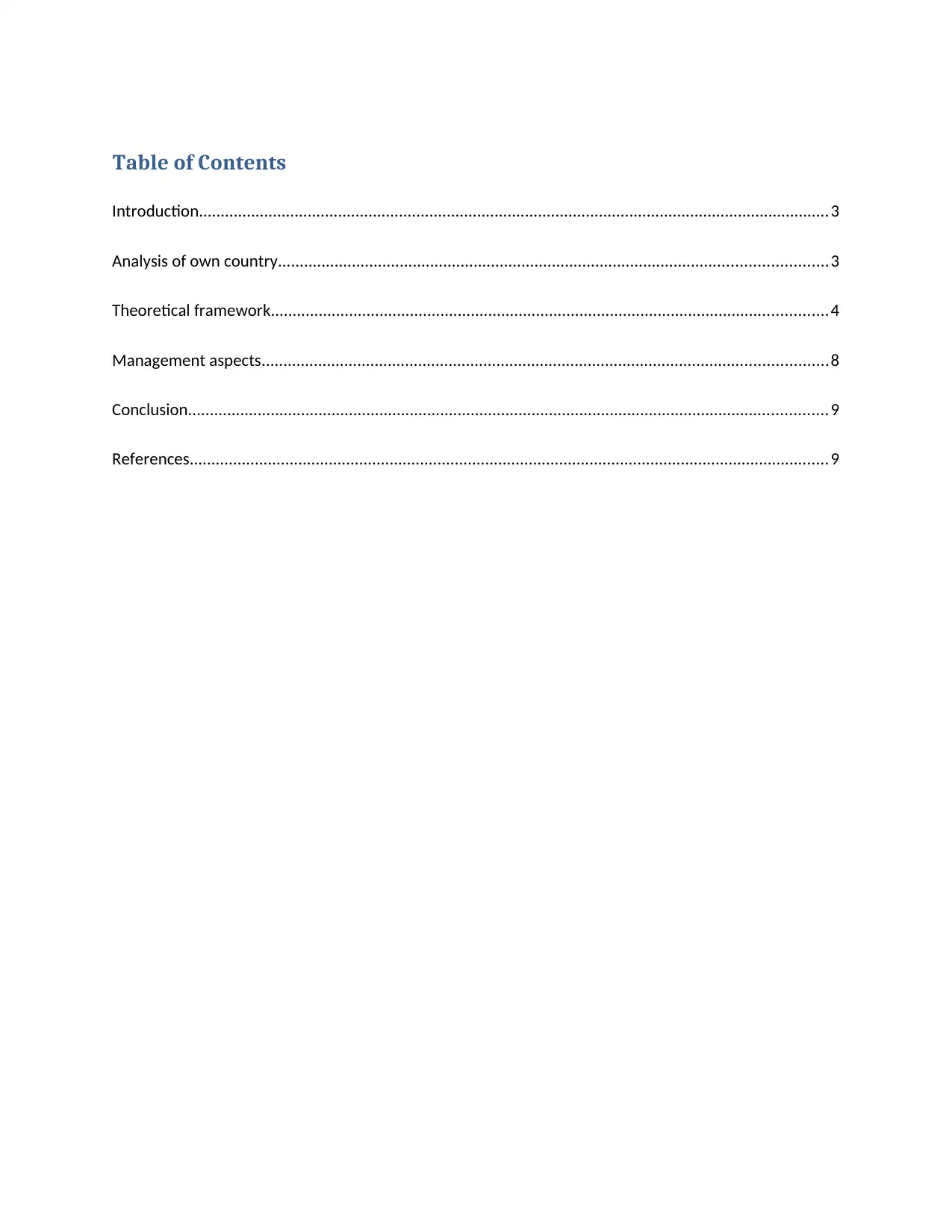
Table of Contents
Introduction.................................................................................................................................................3
Analysis of own country..............................................................................................................................3
Theoretical framework................................................................................................................................4
Management aspects..................................................................................................................................8
Conclusion...................................................................................................................................................9
References...................................................................................................................................................9
Introduction.................................................................................................................................................3
Analysis of own country..............................................................................................................................3
Theoretical framework................................................................................................................................4
Management aspects..................................................................................................................................8
Conclusion...................................................................................................................................................9
References...................................................................................................................................................9
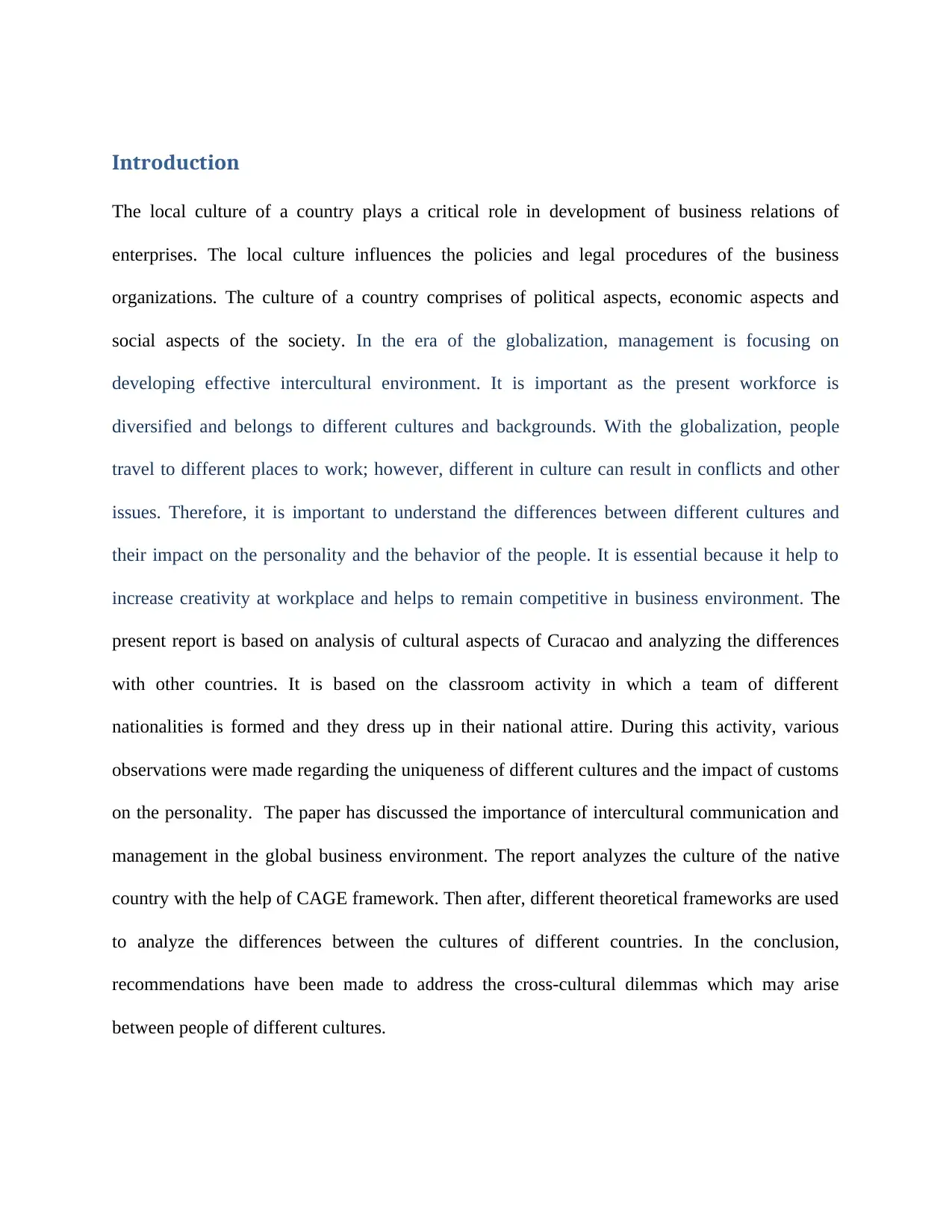
Introduction
The local culture of a country plays a critical role in development of business relations of
enterprises. The local culture influences the policies and legal procedures of the business
organizations. The culture of a country comprises of political aspects, economic aspects and
social aspects of the society. In the era of the globalization, management is focusing on
developing effective intercultural environment. It is important as the present workforce is
diversified and belongs to different cultures and backgrounds. With the globalization, people
travel to different places to work; however, different in culture can result in conflicts and other
issues. Therefore, it is important to understand the differences between different cultures and
their impact on the personality and the behavior of the people. It is essential because it help to
increase creativity at workplace and helps to remain competitive in business environment. The
present report is based on analysis of cultural aspects of Curacao and analyzing the differences
with other countries. It is based on the classroom activity in which a team of different
nationalities is formed and they dress up in their national attire. During this activity, various
observations were made regarding the uniqueness of different cultures and the impact of customs
on the personality. The paper has discussed the importance of intercultural communication and
management in the global business environment. The report analyzes the culture of the native
country with the help of CAGE framework. Then after, different theoretical frameworks are used
to analyze the differences between the cultures of different countries. In the conclusion,
recommendations have been made to address the cross-cultural dilemmas which may arise
between people of different cultures.
The local culture of a country plays a critical role in development of business relations of
enterprises. The local culture influences the policies and legal procedures of the business
organizations. The culture of a country comprises of political aspects, economic aspects and
social aspects of the society. In the era of the globalization, management is focusing on
developing effective intercultural environment. It is important as the present workforce is
diversified and belongs to different cultures and backgrounds. With the globalization, people
travel to different places to work; however, different in culture can result in conflicts and other
issues. Therefore, it is important to understand the differences between different cultures and
their impact on the personality and the behavior of the people. It is essential because it help to
increase creativity at workplace and helps to remain competitive in business environment. The
present report is based on analysis of cultural aspects of Curacao and analyzing the differences
with other countries. It is based on the classroom activity in which a team of different
nationalities is formed and they dress up in their national attire. During this activity, various
observations were made regarding the uniqueness of different cultures and the impact of customs
on the personality. The paper has discussed the importance of intercultural communication and
management in the global business environment. The report analyzes the culture of the native
country with the help of CAGE framework. Then after, different theoretical frameworks are used
to analyze the differences between the cultures of different countries. In the conclusion,
recommendations have been made to address the cross-cultural dilemmas which may arise
between people of different cultures.
⊘ This is a preview!⊘
Do you want full access?
Subscribe today to unlock all pages.

Trusted by 1+ million students worldwide
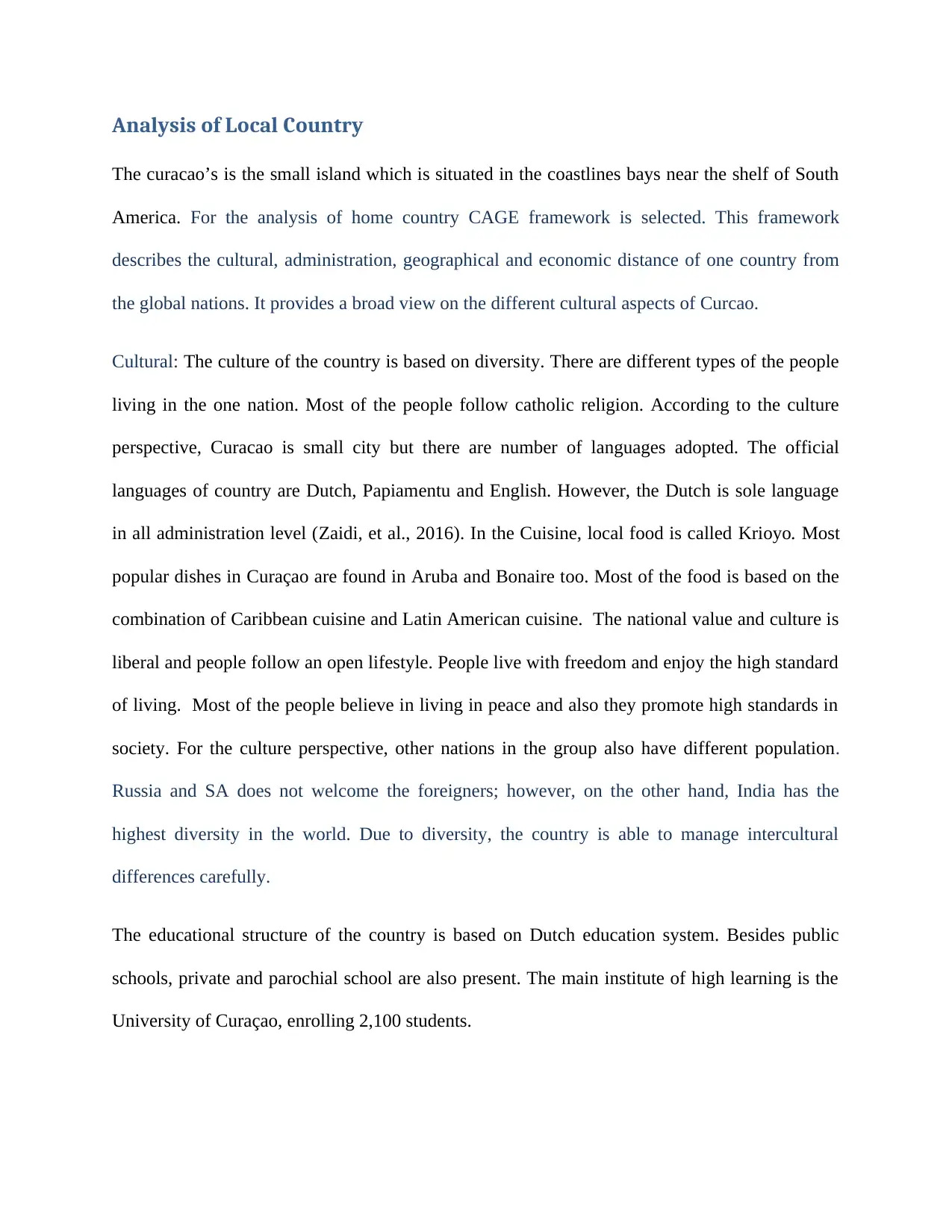
Analysis of Local Country
The curacao’s is the small island which is situated in the coastlines bays near the shelf of South
America. For the analysis of home country CAGE framework is selected. This framework
describes the cultural, administration, geographical and economic distance of one country from
the global nations. It provides a broad view on the different cultural aspects of Curcao.
Cultural: The culture of the country is based on diversity. There are different types of the people
living in the one nation. Most of the people follow catholic religion. According to the culture
perspective, Curacao is small city but there are number of languages adopted. The official
languages of country are Dutch, Papiamentu and English. However, the Dutch is sole language
in all administration level (Zaidi, et al., 2016). In the Cuisine, local food is called Krioyo. Most
popular dishes in Curaçao are found in Aruba and Bonaire too. Most of the food is based on the
combination of Caribbean cuisine and Latin American cuisine. The national value and culture is
liberal and people follow an open lifestyle. People live with freedom and enjoy the high standard
of living. Most of the people believe in living in peace and also they promote high standards in
society. For the culture perspective, other nations in the group also have different population.
Russia and SA does not welcome the foreigners; however, on the other hand, India has the
highest diversity in the world. Due to diversity, the country is able to manage intercultural
differences carefully.
The educational structure of the country is based on Dutch education system. Besides public
schools, private and parochial school are also present. The main institute of high learning is the
University of Curaçao, enrolling 2,100 students.
The curacao’s is the small island which is situated in the coastlines bays near the shelf of South
America. For the analysis of home country CAGE framework is selected. This framework
describes the cultural, administration, geographical and economic distance of one country from
the global nations. It provides a broad view on the different cultural aspects of Curcao.
Cultural: The culture of the country is based on diversity. There are different types of the people
living in the one nation. Most of the people follow catholic religion. According to the culture
perspective, Curacao is small city but there are number of languages adopted. The official
languages of country are Dutch, Papiamentu and English. However, the Dutch is sole language
in all administration level (Zaidi, et al., 2016). In the Cuisine, local food is called Krioyo. Most
popular dishes in Curaçao are found in Aruba and Bonaire too. Most of the food is based on the
combination of Caribbean cuisine and Latin American cuisine. The national value and culture is
liberal and people follow an open lifestyle. People live with freedom and enjoy the high standard
of living. Most of the people believe in living in peace and also they promote high standards in
society. For the culture perspective, other nations in the group also have different population.
Russia and SA does not welcome the foreigners; however, on the other hand, India has the
highest diversity in the world. Due to diversity, the country is able to manage intercultural
differences carefully.
The educational structure of the country is based on Dutch education system. Besides public
schools, private and parochial school are also present. The main institute of high learning is the
University of Curaçao, enrolling 2,100 students.
Paraphrase This Document
Need a fresh take? Get an instant paraphrase of this document with our AI Paraphraser
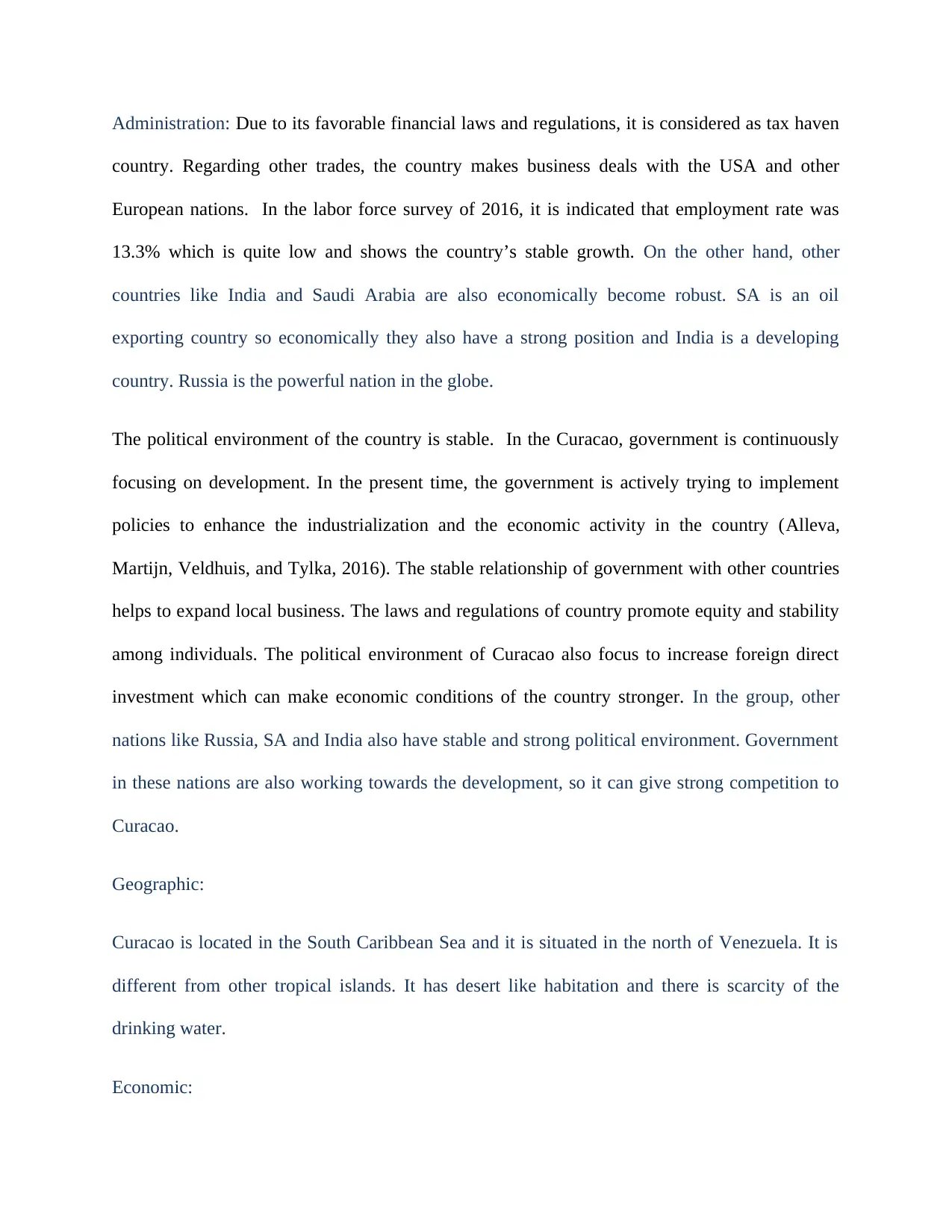
Administration: Due to its favorable financial laws and regulations, it is considered as tax haven
country. Regarding other trades, the country makes business deals with the USA and other
European nations. In the labor force survey of 2016, it is indicated that employment rate was
13.3% which is quite low and shows the country’s stable growth. On the other hand, other
countries like India and Saudi Arabia are also economically become robust. SA is an oil
exporting country so economically they also have a strong position and India is a developing
country. Russia is the powerful nation in the globe.
The political environment of the country is stable. In the Curacao, government is continuously
focusing on development. In the present time, the government is actively trying to implement
policies to enhance the industrialization and the economic activity in the country (Alleva,
Martijn, Veldhuis, and Tylka, 2016). The stable relationship of government with other countries
helps to expand local business. The laws and regulations of country promote equity and stability
among individuals. The political environment of Curacao also focus to increase foreign direct
investment which can make economic conditions of the country stronger. In the group, other
nations like Russia, SA and India also have stable and strong political environment. Government
in these nations are also working towards the development, so it can give strong competition to
Curacao.
Geographic:
Curacao is located in the South Caribbean Sea and it is situated in the north of Venezuela. It is
different from other tropical islands. It has desert like habitation and there is scarcity of the
drinking water.
Economic:
country. Regarding other trades, the country makes business deals with the USA and other
European nations. In the labor force survey of 2016, it is indicated that employment rate was
13.3% which is quite low and shows the country’s stable growth. On the other hand, other
countries like India and Saudi Arabia are also economically become robust. SA is an oil
exporting country so economically they also have a strong position and India is a developing
country. Russia is the powerful nation in the globe.
The political environment of the country is stable. In the Curacao, government is continuously
focusing on development. In the present time, the government is actively trying to implement
policies to enhance the industrialization and the economic activity in the country (Alleva,
Martijn, Veldhuis, and Tylka, 2016). The stable relationship of government with other countries
helps to expand local business. The laws and regulations of country promote equity and stability
among individuals. The political environment of Curacao also focus to increase foreign direct
investment which can make economic conditions of the country stronger. In the group, other
nations like Russia, SA and India also have stable and strong political environment. Government
in these nations are also working towards the development, so it can give strong competition to
Curacao.
Geographic:
Curacao is located in the South Caribbean Sea and it is situated in the north of Venezuela. It is
different from other tropical islands. It has desert like habitation and there is scarcity of the
drinking water.
Economic:
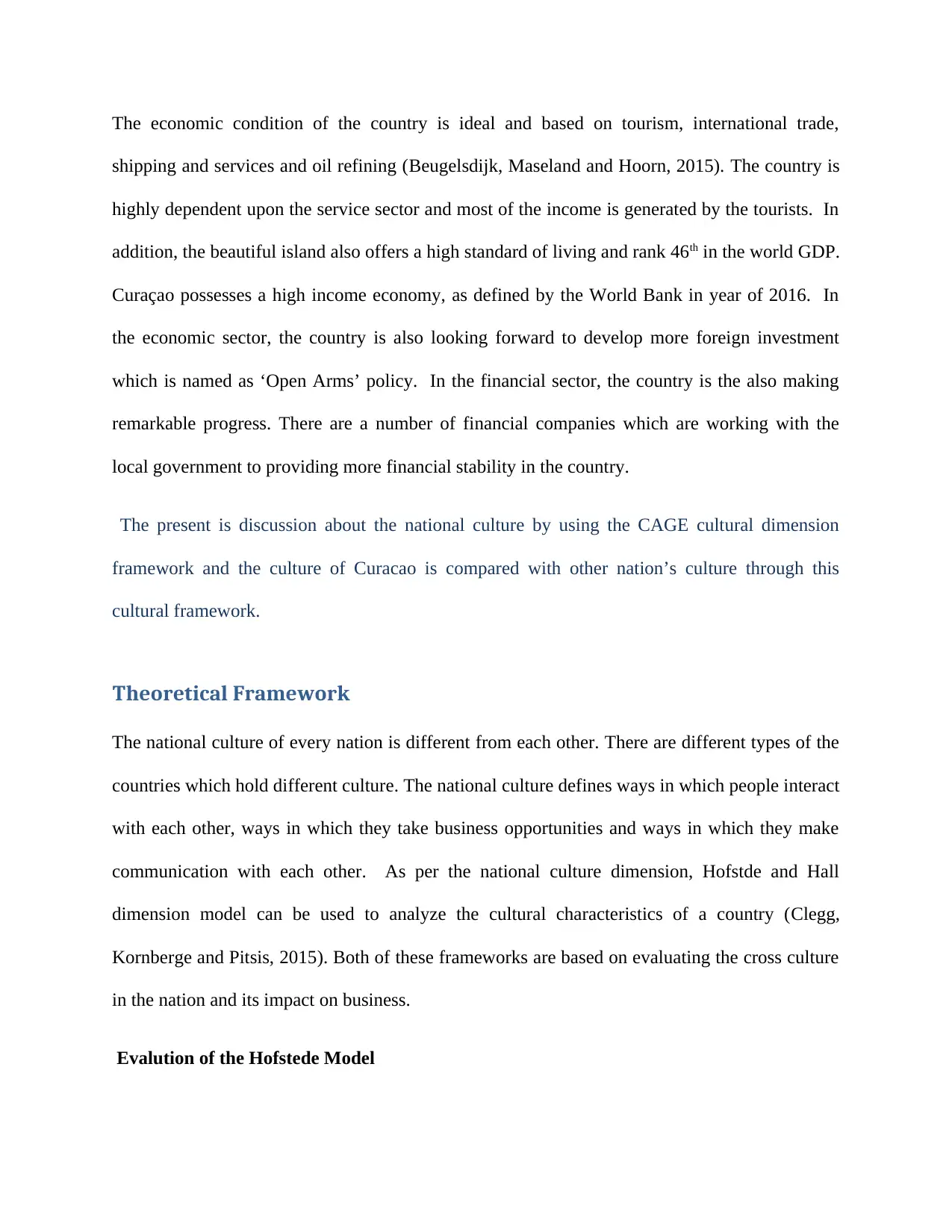
The economic condition of the country is ideal and based on tourism, international trade,
shipping and services and oil refining (Beugelsdijk, Maseland and Hoorn, 2015). The country is
highly dependent upon the service sector and most of the income is generated by the tourists. In
addition, the beautiful island also offers a high standard of living and rank 46th in the world GDP.
Curaçao possesses a high income economy, as defined by the World Bank in year of 2016. In
the economic sector, the country is also looking forward to develop more foreign investment
which is named as ‘Open Arms’ policy. In the financial sector, the country is the also making
remarkable progress. There are a number of financial companies which are working with the
local government to providing more financial stability in the country.
The present is discussion about the national culture by using the CAGE cultural dimension
framework and the culture of Curacao is compared with other nation’s culture through this
cultural framework.
Theoretical Framework
The national culture of every nation is different from each other. There are different types of the
countries which hold different culture. The national culture defines ways in which people interact
with each other, ways in which they take business opportunities and ways in which they make
communication with each other. As per the national culture dimension, Hofstde and Hall
dimension model can be used to analyze the cultural characteristics of a country (Clegg,
Kornberge and Pitsis, 2015). Both of these frameworks are based on evaluating the cross culture
in the nation and its impact on business.
Evalution of the Hofstede Model
shipping and services and oil refining (Beugelsdijk, Maseland and Hoorn, 2015). The country is
highly dependent upon the service sector and most of the income is generated by the tourists. In
addition, the beautiful island also offers a high standard of living and rank 46th in the world GDP.
Curaçao possesses a high income economy, as defined by the World Bank in year of 2016. In
the economic sector, the country is also looking forward to develop more foreign investment
which is named as ‘Open Arms’ policy. In the financial sector, the country is the also making
remarkable progress. There are a number of financial companies which are working with the
local government to providing more financial stability in the country.
The present is discussion about the national culture by using the CAGE cultural dimension
framework and the culture of Curacao is compared with other nation’s culture through this
cultural framework.
Theoretical Framework
The national culture of every nation is different from each other. There are different types of the
countries which hold different culture. The national culture defines ways in which people interact
with each other, ways in which they take business opportunities and ways in which they make
communication with each other. As per the national culture dimension, Hofstde and Hall
dimension model can be used to analyze the cultural characteristics of a country (Clegg,
Kornberge and Pitsis, 2015). Both of these frameworks are based on evaluating the cross culture
in the nation and its impact on business.
Evalution of the Hofstede Model
⊘ This is a preview!⊘
Do you want full access?
Subscribe today to unlock all pages.

Trusted by 1+ million students worldwide
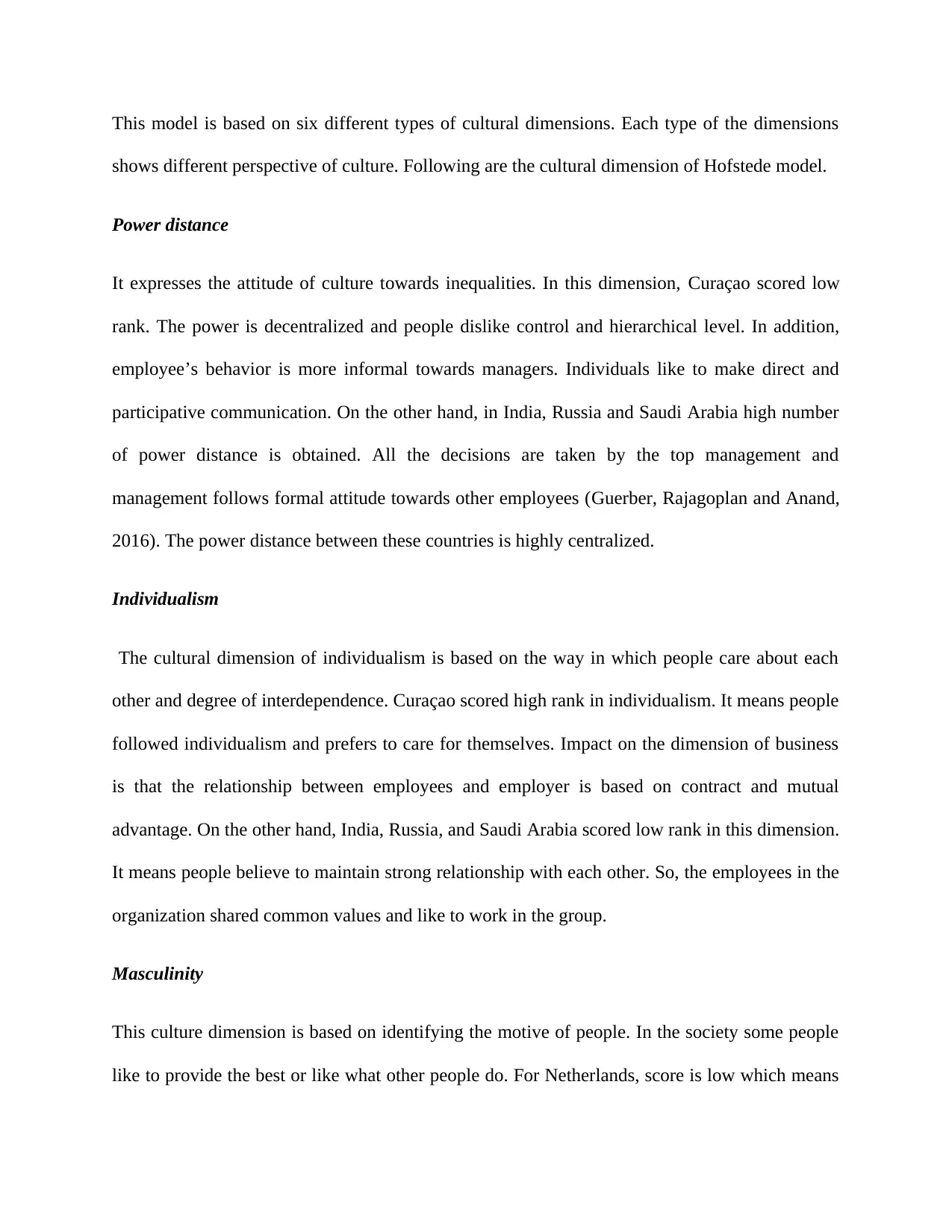
This model is based on six different types of cultural dimensions. Each type of the dimensions
shows different perspective of culture. Following are the cultural dimension of Hofstede model.
Power distance
It expresses the attitude of culture towards inequalities. In this dimension, Curaçao scored low
rank. The power is decentralized and people dislike control and hierarchical level. In addition,
employee’s behavior is more informal towards managers. Individuals like to make direct and
participative communication. On the other hand, in India, Russia and Saudi Arabia high number
of power distance is obtained. All the decisions are taken by the top management and
management follows formal attitude towards other employees (Guerber, Rajagoplan and Anand,
2016). The power distance between these countries is highly centralized.
Individualism
The cultural dimension of individualism is based on the way in which people care about each
other and degree of interdependence. Curaçao scored high rank in individualism. It means people
followed individualism and prefers to care for themselves. Impact on the dimension of business
is that the relationship between employees and employer is based on contract and mutual
advantage. On the other hand, India, Russia, and Saudi Arabia scored low rank in this dimension.
It means people believe to maintain strong relationship with each other. So, the employees in the
organization shared common values and like to work in the group.
Masculinity
This culture dimension is based on identifying the motive of people. In the society some people
like to provide the best or like what other people do. For Netherlands, score is low which means
shows different perspective of culture. Following are the cultural dimension of Hofstede model.
Power distance
It expresses the attitude of culture towards inequalities. In this dimension, Curaçao scored low
rank. The power is decentralized and people dislike control and hierarchical level. In addition,
employee’s behavior is more informal towards managers. Individuals like to make direct and
participative communication. On the other hand, in India, Russia and Saudi Arabia high number
of power distance is obtained. All the decisions are taken by the top management and
management follows formal attitude towards other employees (Guerber, Rajagoplan and Anand,
2016). The power distance between these countries is highly centralized.
Individualism
The cultural dimension of individualism is based on the way in which people care about each
other and degree of interdependence. Curaçao scored high rank in individualism. It means people
followed individualism and prefers to care for themselves. Impact on the dimension of business
is that the relationship between employees and employer is based on contract and mutual
advantage. On the other hand, India, Russia, and Saudi Arabia scored low rank in this dimension.
It means people believe to maintain strong relationship with each other. So, the employees in the
organization shared common values and like to work in the group.
Masculinity
This culture dimension is based on identifying the motive of people. In the society some people
like to provide the best or like what other people do. For Netherlands, score is low which means
Paraphrase This Document
Need a fresh take? Get an instant paraphrase of this document with our AI Paraphraser
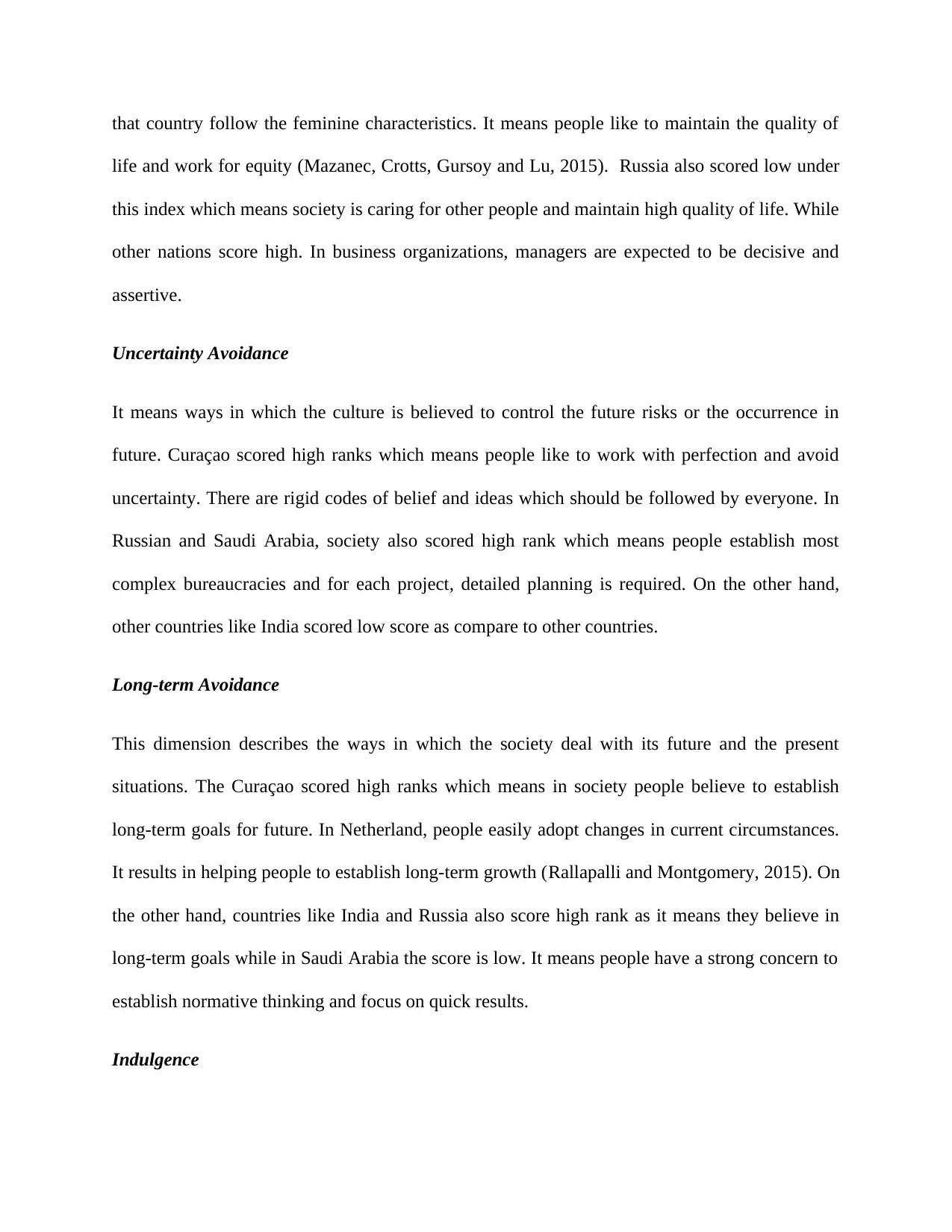
that country follow the feminine characteristics. It means people like to maintain the quality of
life and work for equity (Mazanec, Crotts, Gursoy and Lu, 2015). Russia also scored low under
this index which means society is caring for other people and maintain high quality of life. While
other nations score high. In business organizations, managers are expected to be decisive and
assertive.
Uncertainty Avoidance
It means ways in which the culture is believed to control the future risks or the occurrence in
future. Curaçao scored high ranks which means people like to work with perfection and avoid
uncertainty. There are rigid codes of belief and ideas which should be followed by everyone. In
Russian and Saudi Arabia, society also scored high rank which means people establish most
complex bureaucracies and for each project, detailed planning is required. On the other hand,
other countries like India scored low score as compare to other countries.
Long-term Avoidance
This dimension describes the ways in which the society deal with its future and the present
situations. The Curaçao scored high ranks which means in society people believe to establish
long-term goals for future. In Netherland, people easily adopt changes in current circumstances.
It results in helping people to establish long-term growth (Rallapalli and Montgomery, 2015). On
the other hand, countries like India and Russia also score high rank as it means they believe in
long-term goals while in Saudi Arabia the score is low. It means people have a strong concern to
establish normative thinking and focus on quick results.
Indulgence
life and work for equity (Mazanec, Crotts, Gursoy and Lu, 2015). Russia also scored low under
this index which means society is caring for other people and maintain high quality of life. While
other nations score high. In business organizations, managers are expected to be decisive and
assertive.
Uncertainty Avoidance
It means ways in which the culture is believed to control the future risks or the occurrence in
future. Curaçao scored high ranks which means people like to work with perfection and avoid
uncertainty. There are rigid codes of belief and ideas which should be followed by everyone. In
Russian and Saudi Arabia, society also scored high rank which means people establish most
complex bureaucracies and for each project, detailed planning is required. On the other hand,
other countries like India scored low score as compare to other countries.
Long-term Avoidance
This dimension describes the ways in which the society deal with its future and the present
situations. The Curaçao scored high ranks which means in society people believe to establish
long-term goals for future. In Netherland, people easily adopt changes in current circumstances.
It results in helping people to establish long-term growth (Rallapalli and Montgomery, 2015). On
the other hand, countries like India and Russia also score high rank as it means they believe in
long-term goals while in Saudi Arabia the score is low. It means people have a strong concern to
establish normative thinking and focus on quick results.
Indulgence
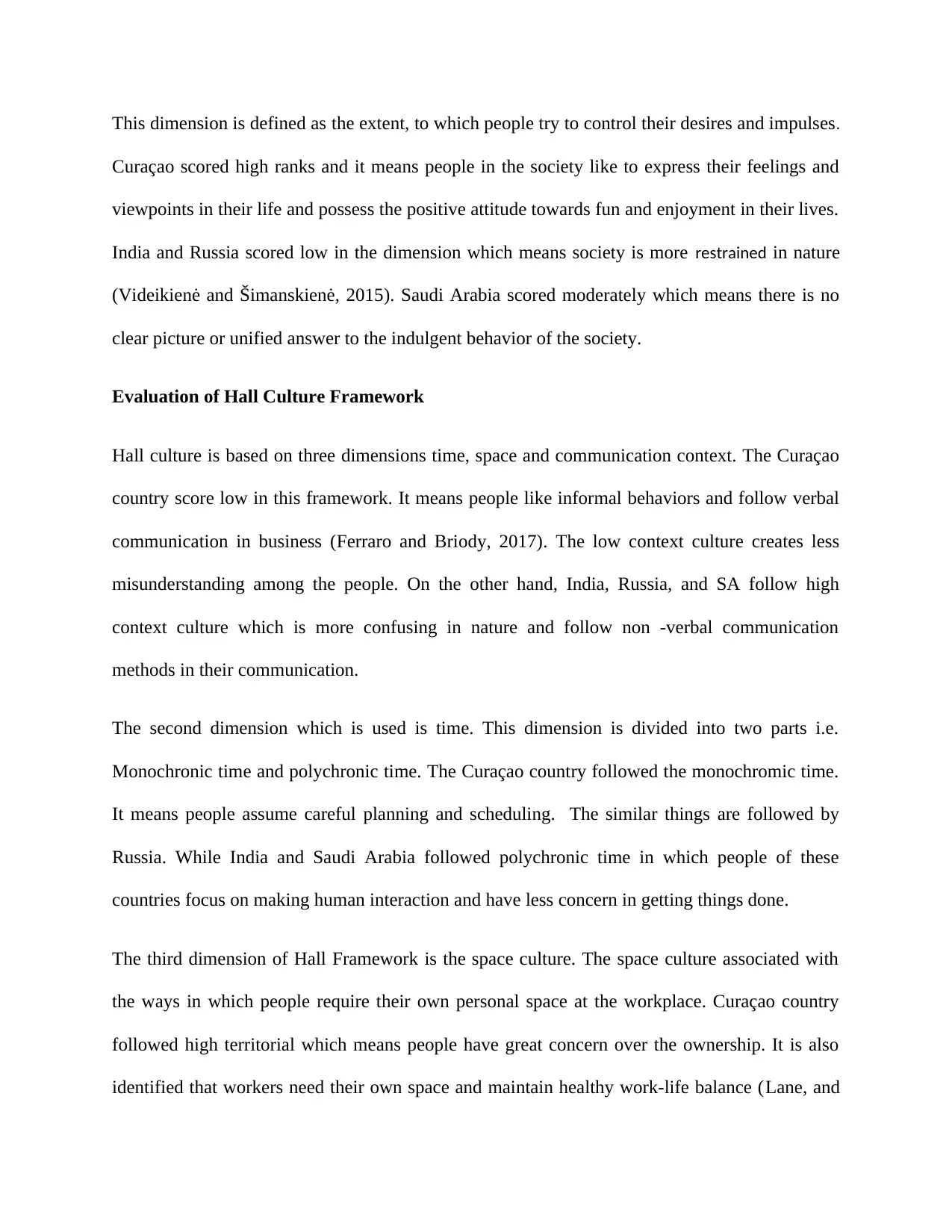
This dimension is defined as the extent, to which people try to control their desires and impulses.
Curaçao scored high ranks and it means people in the society like to express their feelings and
viewpoints in their life and possess the positive attitude towards fun and enjoyment in their lives.
India and Russia scored low in the dimension which means society is more restrained in nature
(Videikienė and Šimanskienė, 2015). Saudi Arabia scored moderately which means there is no
clear picture or unified answer to the indulgent behavior of the society.
Evaluation of Hall Culture Framework
Hall culture is based on three dimensions time, space and communication context. The Curaçao
country score low in this framework. It means people like informal behaviors and follow verbal
communication in business (Ferraro and Briody, 2017). The low context culture creates less
misunderstanding among the people. On the other hand, India, Russia, and SA follow high
context culture which is more confusing in nature and follow non -verbal communication
methods in their communication.
The second dimension which is used is time. This dimension is divided into two parts i.e.
Monochronic time and polychronic time. The Curaçao country followed the monochromic time.
It means people assume careful planning and scheduling. The similar things are followed by
Russia. While India and Saudi Arabia followed polychronic time in which people of these
countries focus on making human interaction and have less concern in getting things done.
The third dimension of Hall Framework is the space culture. The space culture associated with
the ways in which people require their own personal space at the workplace. Curaçao country
followed high territorial which means people have great concern over the ownership. It is also
identified that workers need their own space and maintain healthy work-life balance (Lane, and
Curaçao scored high ranks and it means people in the society like to express their feelings and
viewpoints in their life and possess the positive attitude towards fun and enjoyment in their lives.
India and Russia scored low in the dimension which means society is more restrained in nature
(Videikienė and Šimanskienė, 2015). Saudi Arabia scored moderately which means there is no
clear picture or unified answer to the indulgent behavior of the society.
Evaluation of Hall Culture Framework
Hall culture is based on three dimensions time, space and communication context. The Curaçao
country score low in this framework. It means people like informal behaviors and follow verbal
communication in business (Ferraro and Briody, 2017). The low context culture creates less
misunderstanding among the people. On the other hand, India, Russia, and SA follow high
context culture which is more confusing in nature and follow non -verbal communication
methods in their communication.
The second dimension which is used is time. This dimension is divided into two parts i.e.
Monochronic time and polychronic time. The Curaçao country followed the monochromic time.
It means people assume careful planning and scheduling. The similar things are followed by
Russia. While India and Saudi Arabia followed polychronic time in which people of these
countries focus on making human interaction and have less concern in getting things done.
The third dimension of Hall Framework is the space culture. The space culture associated with
the ways in which people require their own personal space at the workplace. Curaçao country
followed high territorial which means people have great concern over the ownership. It is also
identified that workers need their own space and maintain healthy work-life balance (Lane, and
⊘ This is a preview!⊘
Do you want full access?
Subscribe today to unlock all pages.

Trusted by 1+ million students worldwide
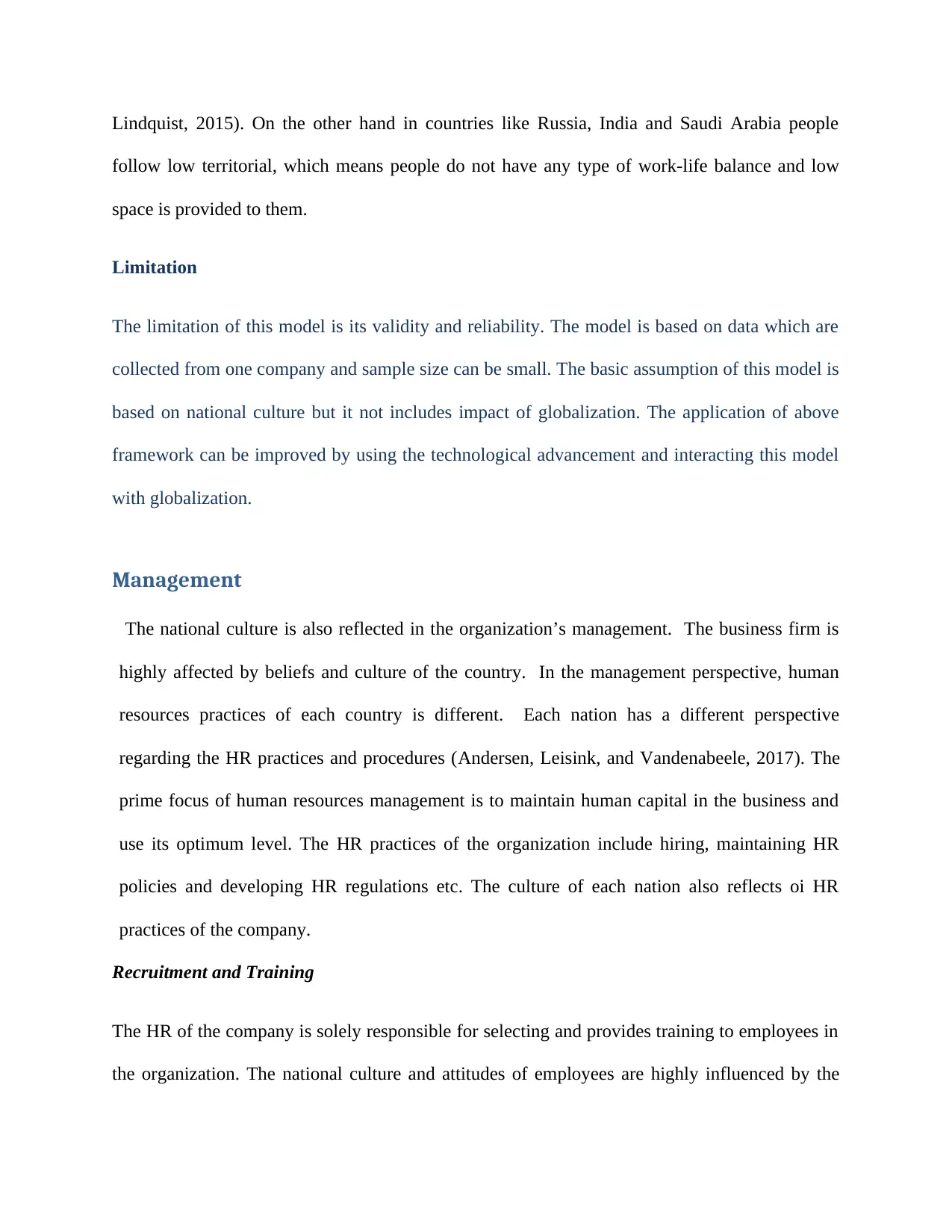
Lindquist, 2015). On the other hand in countries like Russia, India and Saudi Arabia people
follow low territorial, which means people do not have any type of work-life balance and low
space is provided to them.
Limitation
The limitation of this model is its validity and reliability. The model is based on data which are
collected from one company and sample size can be small. The basic assumption of this model is
based on national culture but it not includes impact of globalization. The application of above
framework can be improved by using the technological advancement and interacting this model
with globalization.
Management
The national culture is also reflected in the organization’s management. The business firm is
highly affected by beliefs and culture of the country. In the management perspective, human
resources practices of each country is different. Each nation has a different perspective
regarding the HR practices and procedures (Andersen, Leisink, and Vandenabeele, 2017). The
prime focus of human resources management is to maintain human capital in the business and
use its optimum level. The HR practices of the organization include hiring, maintaining HR
policies and developing HR regulations etc. The culture of each nation also reflects oi HR
practices of the company.
Recruitment and Training
The HR of the company is solely responsible for selecting and provides training to employees in
the organization. The national culture and attitudes of employees are highly influenced by the
follow low territorial, which means people do not have any type of work-life balance and low
space is provided to them.
Limitation
The limitation of this model is its validity and reliability. The model is based on data which are
collected from one company and sample size can be small. The basic assumption of this model is
based on national culture but it not includes impact of globalization. The application of above
framework can be improved by using the technological advancement and interacting this model
with globalization.
Management
The national culture is also reflected in the organization’s management. The business firm is
highly affected by beliefs and culture of the country. In the management perspective, human
resources practices of each country is different. Each nation has a different perspective
regarding the HR practices and procedures (Andersen, Leisink, and Vandenabeele, 2017). The
prime focus of human resources management is to maintain human capital in the business and
use its optimum level. The HR practices of the organization include hiring, maintaining HR
policies and developing HR regulations etc. The culture of each nation also reflects oi HR
practices of the company.
Recruitment and Training
The HR of the company is solely responsible for selecting and provides training to employees in
the organization. The national culture and attitudes of employees are highly influenced by the
Paraphrase This Document
Need a fresh take? Get an instant paraphrase of this document with our AI Paraphraser
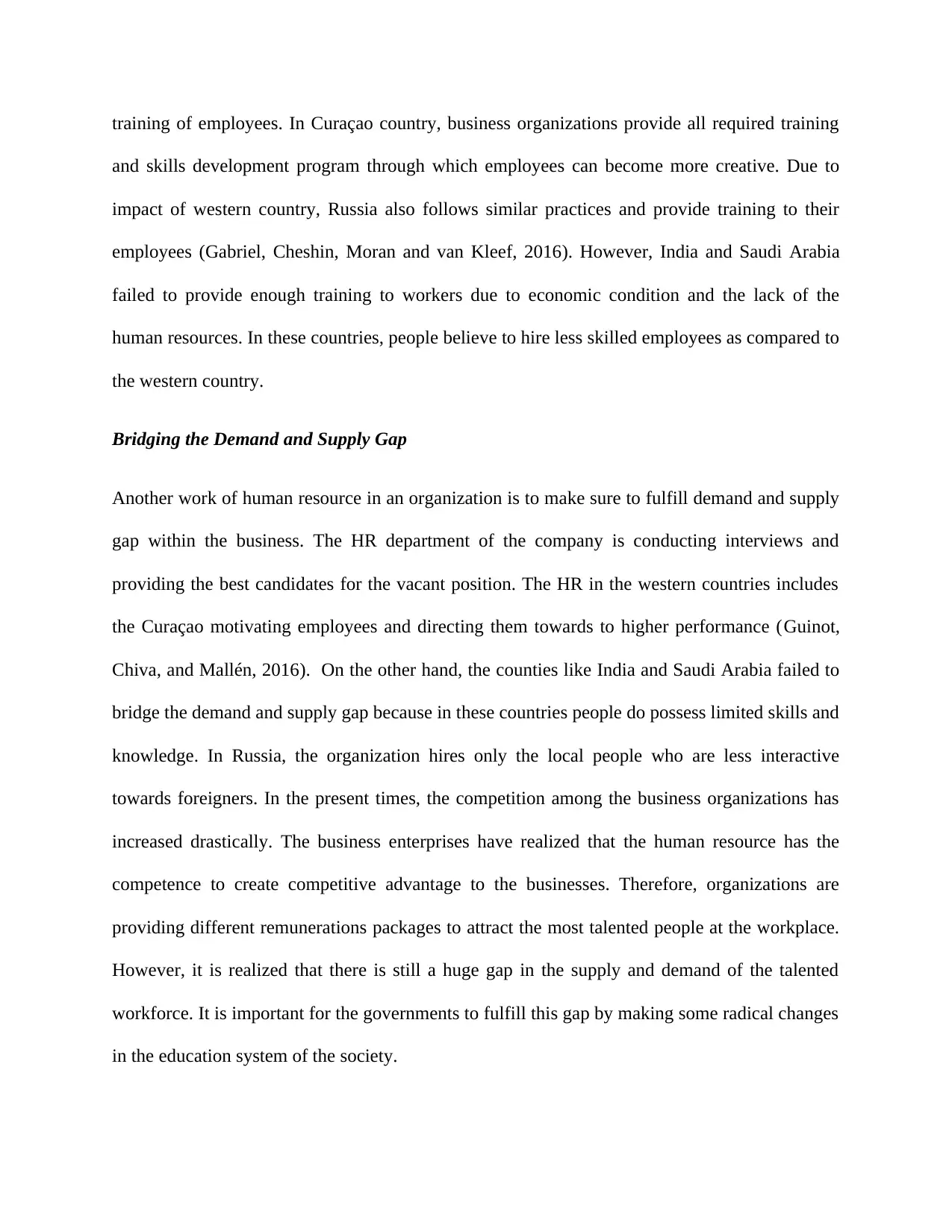
training of employees. In Curaçao country, business organizations provide all required training
and skills development program through which employees can become more creative. Due to
impact of western country, Russia also follows similar practices and provide training to their
employees (Gabriel, Cheshin, Moran and van Kleef, 2016). However, India and Saudi Arabia
failed to provide enough training to workers due to economic condition and the lack of the
human resources. In these countries, people believe to hire less skilled employees as compared to
the western country.
Bridging the Demand and Supply Gap
Another work of human resource in an organization is to make sure to fulfill demand and supply
gap within the business. The HR department of the company is conducting interviews and
providing the best candidates for the vacant position. The HR in the western countries includes
the Curaçao motivating employees and directing them towards to higher performance (Guinot,
Chiva, and Mallén, 2016). On the other hand, the counties like India and Saudi Arabia failed to
bridge the demand and supply gap because in these countries people do possess limited skills and
knowledge. In Russia, the organization hires only the local people who are less interactive
towards foreigners. In the present times, the competition among the business organizations has
increased drastically. The business enterprises have realized that the human resource has the
competence to create competitive advantage to the businesses. Therefore, organizations are
providing different remunerations packages to attract the most talented people at the workplace.
However, it is realized that there is still a huge gap in the supply and demand of the talented
workforce. It is important for the governments to fulfill this gap by making some radical changes
in the education system of the society.
and skills development program through which employees can become more creative. Due to
impact of western country, Russia also follows similar practices and provide training to their
employees (Gabriel, Cheshin, Moran and van Kleef, 2016). However, India and Saudi Arabia
failed to provide enough training to workers due to economic condition and the lack of the
human resources. In these countries, people believe to hire less skilled employees as compared to
the western country.
Bridging the Demand and Supply Gap
Another work of human resource in an organization is to make sure to fulfill demand and supply
gap within the business. The HR department of the company is conducting interviews and
providing the best candidates for the vacant position. The HR in the western countries includes
the Curaçao motivating employees and directing them towards to higher performance (Guinot,
Chiva, and Mallén, 2016). On the other hand, the counties like India and Saudi Arabia failed to
bridge the demand and supply gap because in these countries people do possess limited skills and
knowledge. In Russia, the organization hires only the local people who are less interactive
towards foreigners. In the present times, the competition among the business organizations has
increased drastically. The business enterprises have realized that the human resource has the
competence to create competitive advantage to the businesses. Therefore, organizations are
providing different remunerations packages to attract the most talented people at the workplace.
However, it is realized that there is still a huge gap in the supply and demand of the talented
workforce. It is important for the governments to fulfill this gap by making some radical changes
in the education system of the society.
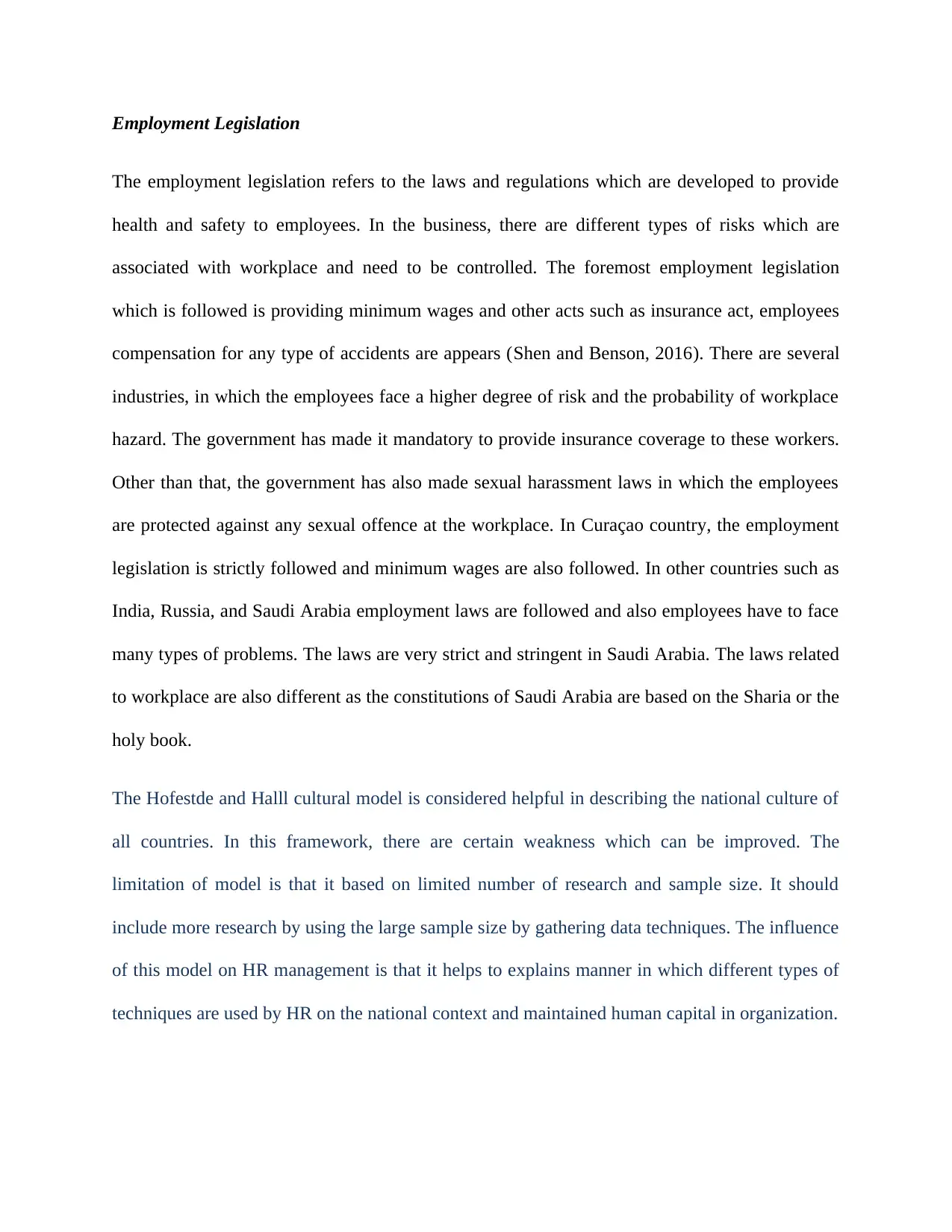
Employment Legislation
The employment legislation refers to the laws and regulations which are developed to provide
health and safety to employees. In the business, there are different types of risks which are
associated with workplace and need to be controlled. The foremost employment legislation
which is followed is providing minimum wages and other acts such as insurance act, employees
compensation for any type of accidents are appears (Shen and Benson, 2016). There are several
industries, in which the employees face a higher degree of risk and the probability of workplace
hazard. The government has made it mandatory to provide insurance coverage to these workers.
Other than that, the government has also made sexual harassment laws in which the employees
are protected against any sexual offence at the workplace. In Curaçao country, the employment
legislation is strictly followed and minimum wages are also followed. In other countries such as
India, Russia, and Saudi Arabia employment laws are followed and also employees have to face
many types of problems. The laws are very strict and stringent in Saudi Arabia. The laws related
to workplace are also different as the constitutions of Saudi Arabia are based on the Sharia or the
holy book.
The Hofestde and Halll cultural model is considered helpful in describing the national culture of
all countries. In this framework, there are certain weakness which can be improved. The
limitation of model is that it based on limited number of research and sample size. It should
include more research by using the large sample size by gathering data techniques. The influence
of this model on HR management is that it helps to explains manner in which different types of
techniques are used by HR on the national context and maintained human capital in organization.
The employment legislation refers to the laws and regulations which are developed to provide
health and safety to employees. In the business, there are different types of risks which are
associated with workplace and need to be controlled. The foremost employment legislation
which is followed is providing minimum wages and other acts such as insurance act, employees
compensation for any type of accidents are appears (Shen and Benson, 2016). There are several
industries, in which the employees face a higher degree of risk and the probability of workplace
hazard. The government has made it mandatory to provide insurance coverage to these workers.
Other than that, the government has also made sexual harassment laws in which the employees
are protected against any sexual offence at the workplace. In Curaçao country, the employment
legislation is strictly followed and minimum wages are also followed. In other countries such as
India, Russia, and Saudi Arabia employment laws are followed and also employees have to face
many types of problems. The laws are very strict and stringent in Saudi Arabia. The laws related
to workplace are also different as the constitutions of Saudi Arabia are based on the Sharia or the
holy book.
The Hofestde and Halll cultural model is considered helpful in describing the national culture of
all countries. In this framework, there are certain weakness which can be improved. The
limitation of model is that it based on limited number of research and sample size. It should
include more research by using the large sample size by gathering data techniques. The influence
of this model on HR management is that it helps to explains manner in which different types of
techniques are used by HR on the national context and maintained human capital in organization.
⊘ This is a preview!⊘
Do you want full access?
Subscribe today to unlock all pages.

Trusted by 1+ million students worldwide
1 out of 16
Related Documents
Your All-in-One AI-Powered Toolkit for Academic Success.
+13062052269
info@desklib.com
Available 24*7 on WhatsApp / Email
![[object Object]](/_next/static/media/star-bottom.7253800d.svg)
Unlock your academic potential
Copyright © 2020–2025 A2Z Services. All Rights Reserved. Developed and managed by ZUCOL.





